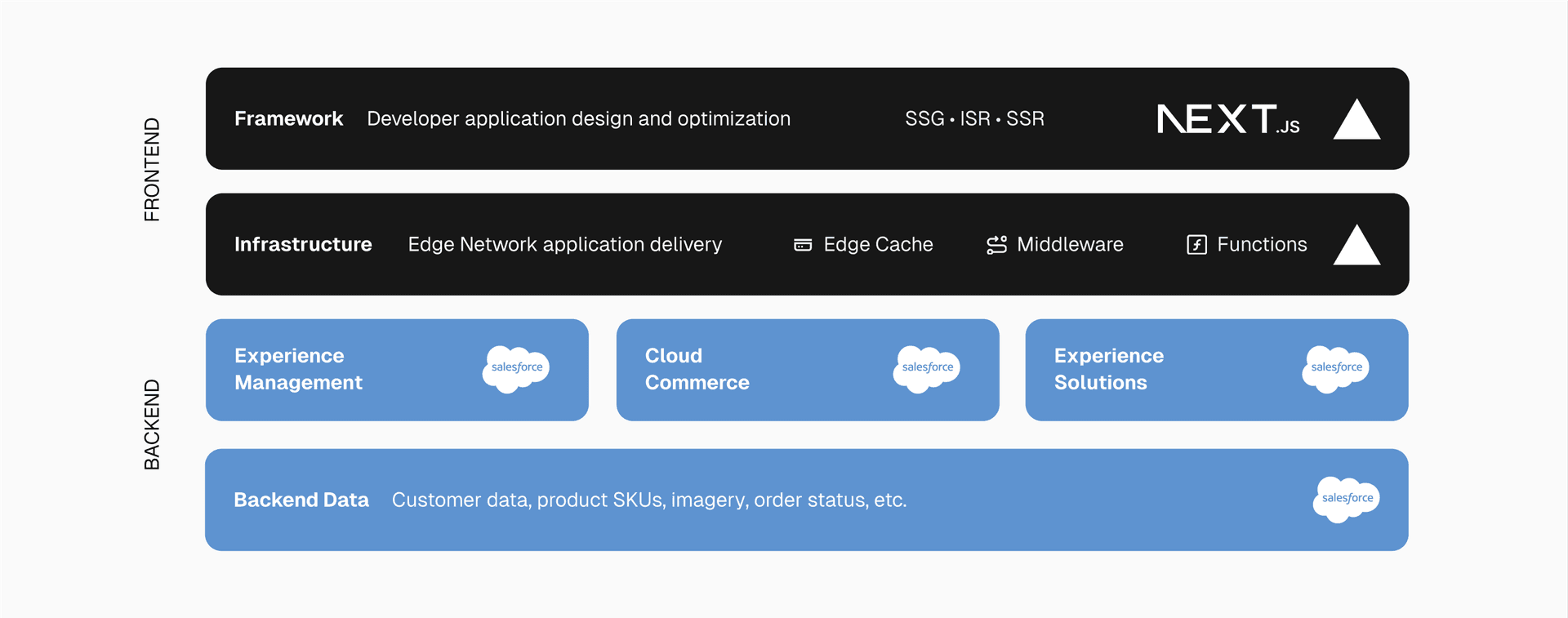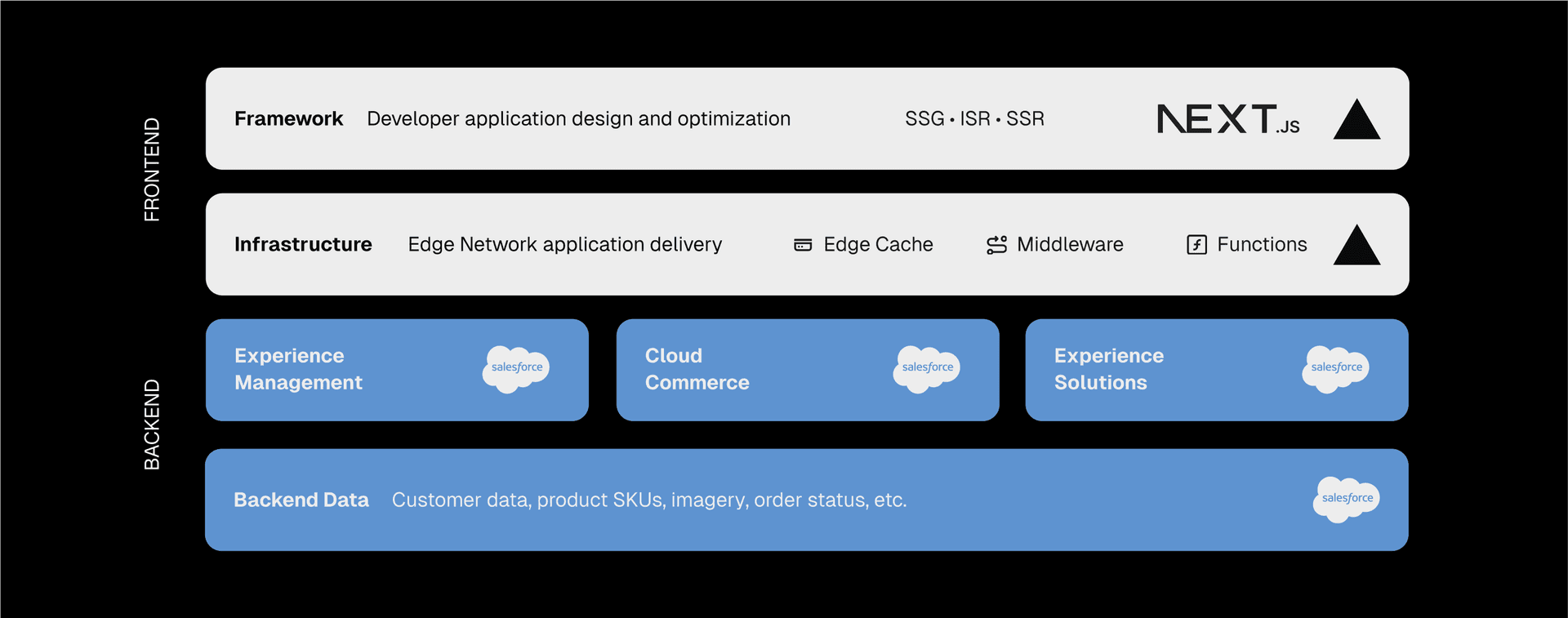5 min read
Keep your commerce backend and de-risk your migration.
For ecommerce teams running Salesforce Commerce Cloud, the platform's monolithic design can feel like a double-edged sword. While its out-of-the-box capabilities promise rapid deployments, they often hinder frontend flexibility and innovation. But what if you could unlock a new level of performance—without risking your core business?
That’s exactly what a global sportswear brand achieved. Their headless Salesforce migration strategy halved their load times, cut cart abandonment by 28%, and increased mobile conversion rates by 15%. All without a disruptive, big-bang migration.
Here’s how they did it and how you can too.
We now have visibility into our performance we never had before. When issues arise, we can pinpoint and fix them faster. That said, during BFCM, we're so bored because nothing's happening—we're just watching the sales go up.
Link to headingThe case for migration
Ecommerce teams often outgrow Salesforce Commerce Cloud's monolithic architecture for a few reasons:
Architectural constraints: Teams are forced to implement personalization client-side, leading to duplicate downloads and slower page loads
Limited tooling choices: Integrating best-in-class solutions often requires clunky workarounds, leaving engineers feeling constrained in technical choices to build better features and experiences
Scalability struggles: During peak traffic events, issues like bloated tag managers, inefficient data pipelines, and unoptimized assets make Salesforce sites prone to slowdowns or worse—downtime
These limitations affect more than just performance and sales. They hurt developer experience by requiring specialized skills and tribal knowledge, which limits your ability to hire and retain talent.
This prevents you from setting a strong foundation for the future, and it contributes to poor user experiences that frustrate customers and drive them away.
Link to headingMigration strategy: Moving forward without the risks
Replacing an ecommerce platform wholesale is daunting, especially when it handles millions or billions in annual revenue. Instead, teams can take an incremental approach, focusing on these key areas:
Choosing the right frontend framework: While Salesforce offers PWA Kit as a frontend solution, Next.js provides a more robust and flexible approach for large-scale ecommerce sites and benefits from an active open-source community. Next.js includes server-side rendering, image optimization, built-in routing, and vast community libraries of pre-built components. This accelerates development and allows for seamless integration with various backend systems, including Salesforce Commerce Cloud.
Planning for incremental traffic management: Edge Middleware—built into Next.js and supported by the Vercel platform—allows for intelligent and gradual traffic rerouting between your new Vercel-hosted application and your existing application.
Ensuring business continuity: Preserve existing data and integrations while progressively introducing a new headless layer.
This strategy enables you to migrate one page or route at a time, minimizing risk during the transition. You get immediate access to modern frontend capabilities while maintaining your existing Salesforce backend infrastructure, allowing you to upgrade at your own pace.
Link to headingTechnical strategies for a smooth migration
Transitioning your ecommerce platform can feel overwhelming, but these practical tips ensure a smooth transition while minimizing risks.
Link to headingStart with the frontend
Build a new presentation with Next.js while keeping Salesforce Commerce Cloud as the backend. This approach allows you to tackle performance issues incrementally without a full system overhaul.
Start small with a single page or route of your application. You can choose a less critical or lower-traffic page to ensure everything works correctly.


Link to headingUse Edge Middleware for traffic control
Use Edge Middleware to create a reverse proxy by defining rewrites directly in your Next.js configuration. This dynamically routes traffic between your existing app and your new Next.js app on Vercel. For further control, you can also add A/B testing or use percentage-based rollouts.
This approach enables you to incrementally migrate and test features progressively. Deploying your app to Vercel also enables near-instant rollback capabilities if something goes wrong.
Link to headingSynchronize user sessions
Implement shared session strategies, such as encrypted cookies and centralized session storage, to ensure a consistent user experience across both platforms. This prevents users from experiencing issues like having to log in twice or losing shopping cart items.
Additionally, you can set up JWT-based authentication to pass user data securely between apps without database lookups. Edge validation ensures consistent user states across the platform while maintaining sub-100ms response times.
Link to headingPreserve SEO rankings
To avoid disrupting search engine visibility, maintain existing URL structures and manage redirects carefully, using Edge Middleware to ensure minimal latency for users. Implement proper canonical tags and monitor Google Search Console as you move pages and compare old data to new data to ensure continuity.
Link to headingTest in real-world conditions
Use Salesforce Commerce Cloud's sandbox environments to create pre-production instances with representative data. This allows you to thoroughly test your Next.js frontend against realistic data sets without affecting your live store.
Vercel’s preview deployments create a unique URL, allowing you to test changes before they go live. You may also configure custom environments on Vercel to mimic your organization’s workflow.
Link to headingMitigate Salesforce API challenges
Next.js's composability provides granular control over data fetching and caching. By strategically caching API responses and leveraging Incremental Static Regeneration (ISR), you can significantly reduce the number of requests to Salesforce Commerce Cloud, minimize API rate limit issues, and improve overall performance.
Link to headingResults: Performance and business gains
When we recently helped a global sportswear brand through this migration, they saw measurable improvements in site performance, developer productivity, and revenue.
They began with their homepage as an isolated test case, but when they saw great results, they accelerated their entire migration timeline from five months to two month.
Link to headingPerformance metrics
During high-traffic periods, the new architecture proved to be 10x faster than Salesforce Commerce Cloud alone in load testing. This improvement came from edge computing, server-side rendering, and optimized data management.
Core Web Vitals directly relate to search ranking and site usability. All metrics saw sizable improvements:
Time to First Byte (TTFB): 2.0s → 0.8s
First Contentful Paint (FCP): 3.2s → 1.8s
Largest Contentful Paint (LCP): 4.0s → 2.4s
Interaction to Next Paint (INP): 350ms → 200ms
Cumulative Layout Shift (CLS): 0.1 (maintained)
Link to headingProductivity improvements
Development teams were able to release more frequently—and with more confidence—in a more enjoyable working environment.
Deployment times reduced from hours to minutes
Rollback times reduced to seconds
Feature deployment controlled via feature flags
40% improvement in development team retention
Link to headingBusiness impact
Improving the infrastructure and user experience directly translated to better converts and revenue.
28% decrease in cart abandonment rates
15% increase in mobile conversion rates
$10M in incremental quarterly online sales
Zero downtime during Black Friday, even with 125,000+ concurrent users
Like most major platform transitions, this migration is an ongoing journey. The team plans several upcoming improvements, including a microservices-based checkout system, optimization of third-party scripts, and moving personalization to the edge.
The team remains confident in their direction, thanks to their enhanced capability to quickly spot, evaluate, and fix issues through better monitoring and regular performance audits with our professional services team.
Link to headingThe key takeaways
Migrating away from Salesforce Commerce Cloud doesn’t have to mean starting over. By focusing on the frontend and leveraging tools that allow an at-your-own-pace approach, you can unlock a faster, more scalable platform—without the risks of full re-platforming. The key to success is to start small and partner with experts who have done this before.
Ready to see what a migration looks like for you? Contact our team to start your migration today.